EasyDCIM Colocation For WHMCS
Contents |
About EasyDCIM Colocation For WHMCS
| EasyDCIM Colocation For WHMCS is a free module that will allow you to provide and manage your EasyDCIM colocation services from the WHMCS area. You will be enabled to, among others, determine the status of each colocation, and your clients - turn off and on their power outlets remotely. |
- Admin Area Features:
| ✔ Create/Terminate/Suspend/Unsuspend Colocation |
| ✔ Update Order Information |
| ✔ One Click Login To User Control Panel |
| ✔ View Service Information |
| ✔ View Colocation Resource Usage: |
| ✔ Bandwidth Statistics |
| ✔ Power Usage Statistics And Graph |
| ✔ Aggregate Traffic Graph |
| ✔ Configure Default Colocation Options: |
| ✔ Model |
| ✔ Location |
| ✔ Configure Automation Settings: |
| ✔ Toggle Automatic Order Acceptance |
| ✔ Block Automatic Suspension/Unsuspension/Termination By WHMCS |
| ✔ Control Service Access Level |
| ✔ Define Client Area Features: |
| ✔ Toggle Service Information: |
| ✔ Label |
| ✔ Model |
| ✔ Location |
| ✔ Labeled Rack With Position |
| ✔ IP Addresses |
| ✔ Custom Metadata |
| ✔ Allow Server Management: |
| ✔ Traffic Statistics |
| ✔ Power Usage Statistics |
| ✔ Power Outlets |
| ✔ Devices List |
| ✔ Allow Server Actions: |
| ✔ Log Into Panel |
| ✔ Toggle Traffic Statistics: |
| ✔ Aggregate Traffic Graph |
| ✔ Hide Bandwidth Usage Table |
| ✔ Hide Network Ports Table |
| ✔ Toggle Power Usage |
| ✔ Enable Power Usage Graph |
| ✔ Hide Power Usage Table |
| ✔ Toggle Devices List |
| ✔ Enable Devices Power Control |
| ✔ Control Service Actions And Email Notifications |
| ✔ Generate Default Configurable Options |
- Client Area Features:
| ✔ View Colocation Information: |
| ✔ Model |
| ✔ Label |
| ✔ Location |
| ✔ Labeled Rack With Position |
| ✔ IP Addresses |
| ✔ Custom Metadata |
| ✔ One Click Login To User Control Panel |
| ✔ View Traffic Statistics: |
| ✔ Bandwidth Usage |
| ✔ Aggregate Traffic Graph |
| ✔ Network Ports |
| ✔ View Power Usage Statistics: |
| ✔ In Given Intervals |
| ✔ As Power Usage Graph |
| ✔ Manage Reverse DNS Records |
| ✔ Enable/Disable/Restart Power Outlets |
| ✔ Power On/Shutdown/Reboot Colocation Devices |
- Configurable Options:
| ✔ Colocation Model |
| ✔ Colocation Location |
| ✔ Bandwidth Limit |
| ✔ Bandwidth OUT Limit |
| ✔ Bandwidth IN Limit |
| ✔ Power Usage |
| ✔ 95th Percentile |
- Advanced Billing Integration:
| ✔ Bill For Current Power Usage |
| ✔ Bill For In/Out/Total Bandwidth Usage |
| ✔ Apply 95th Percentile Billing Of In/Out/Total Bandwidth Overages |
- Supported PDU Manufacturers:
| ✔ APC |
| ✔ CyberPower |
| ✔ Enlogic |
| ✔ Raritan |
| ✔ Eaton |
| ✔ SmartPDU |
- General Info:
| ✔ Integrated With Advanced Billing For WHMCS - Actual Server Resource Usage Billing |
| ✔ Multi-Language Support |
| ✔ Supports EasyDCIM v1.13.0 And Later |
| ✔ Supports PHP 8.3 Back To PHP 8.1 |
| ✔ Supports WHMCS Themes "Six", "Twenty-One" And "Lagom WHMCS Client Theme" |
| ✔ Supports WHMCS V8.13 Back To WHMCS V8.10 |
- Exclusive Promo Code From ModulesGarden:
| ✔ Save 25% For 3 Months On The EasyDCIM Control Panel With Coupon: WHMCS25%_ED |
Installation and Configuration
| This tutorial will show you how to successfully install and configure EasyDCIM Colocation For WHMCS. We will guide you step by step through the whole installation and configuration process. |
Installation
| 1. Log in to our client area and download the module. |
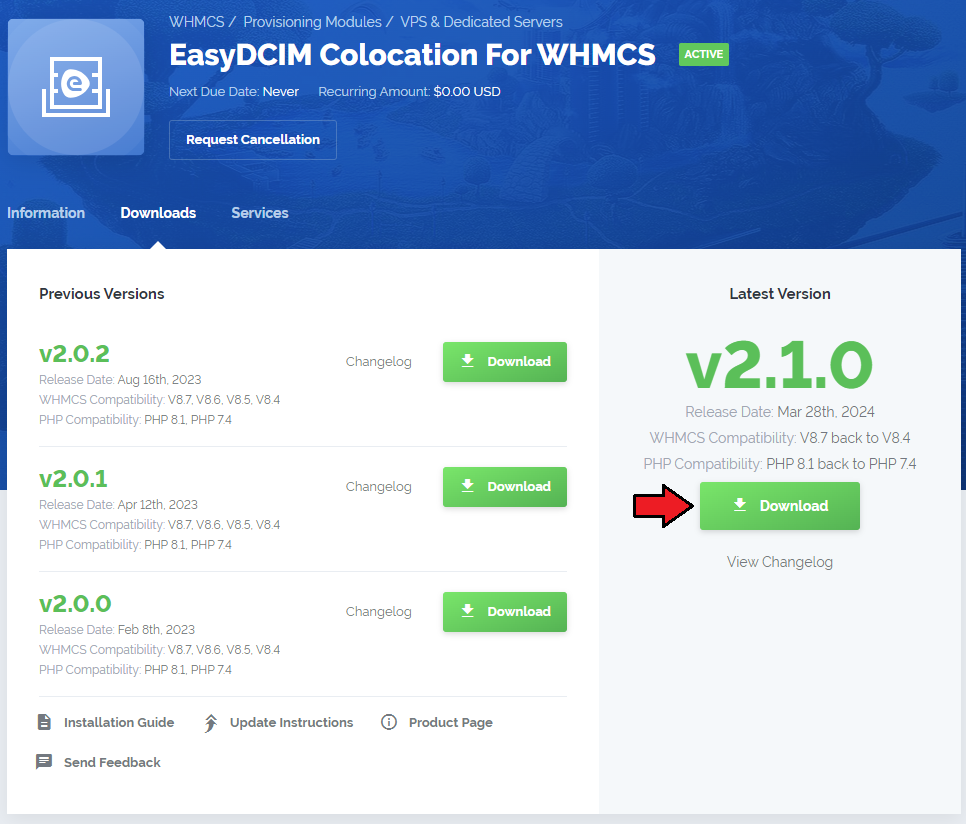
|
| 2. Extract the downloaded file into the main WHMCS directory. The content of the package should look like this. |

|
| If you are about to update your EasyDCIM Colocation module from v1 to v2? Remember to strictly follow the update instructions described at the bottom of this documentation! |
Configuration of Server
| 3. Now, we will show you how to configure a new product. Go to 'System Settings' → 'Servers' and press the 'Add New Server' button. |
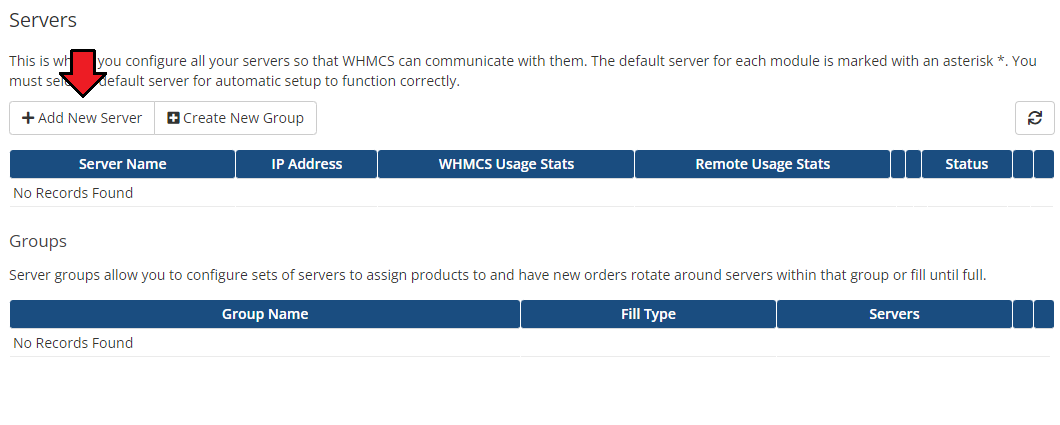
|
| 4. Next, choose 'EasyDCIMColocationv2' from the 'Type' dropdown menu. Fill in your server name, address, username and password (API Key). Then check the connection with the EasyDCIM V2 server and press 'Save Changes'. |
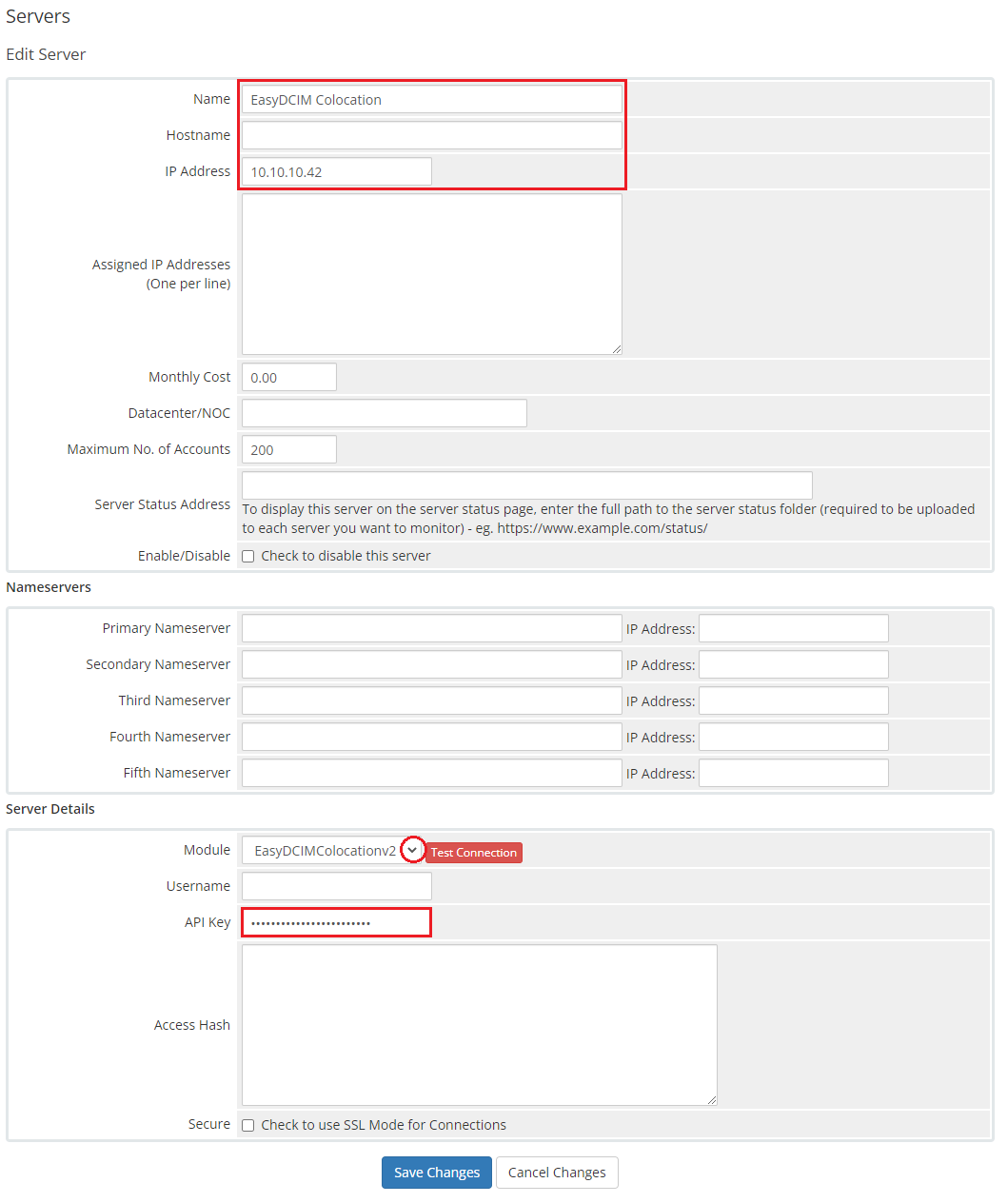
|
| 5. The next step is creating a server group. To do so, click on 'Create Server Group'. |
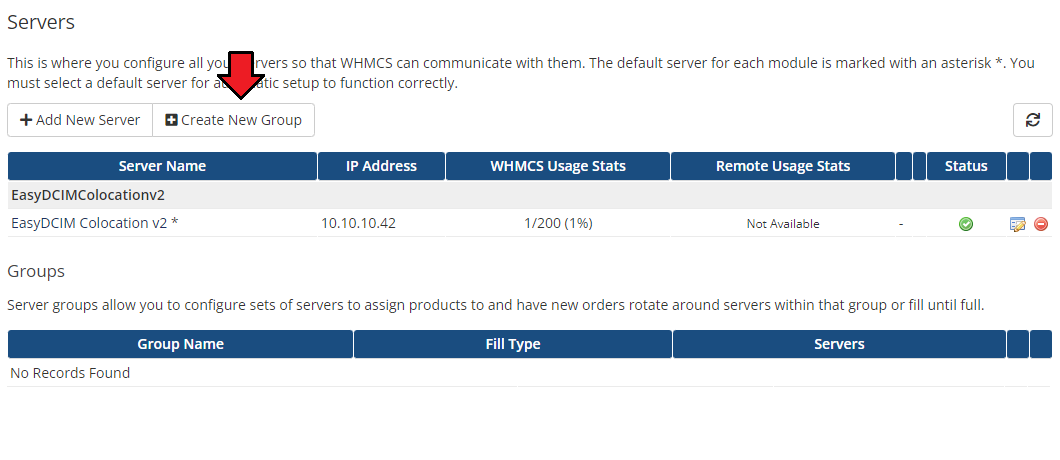
|
| 6. Enter the name, click on your previously created server, press 'Add' and 'Save Changes' afterwards. |
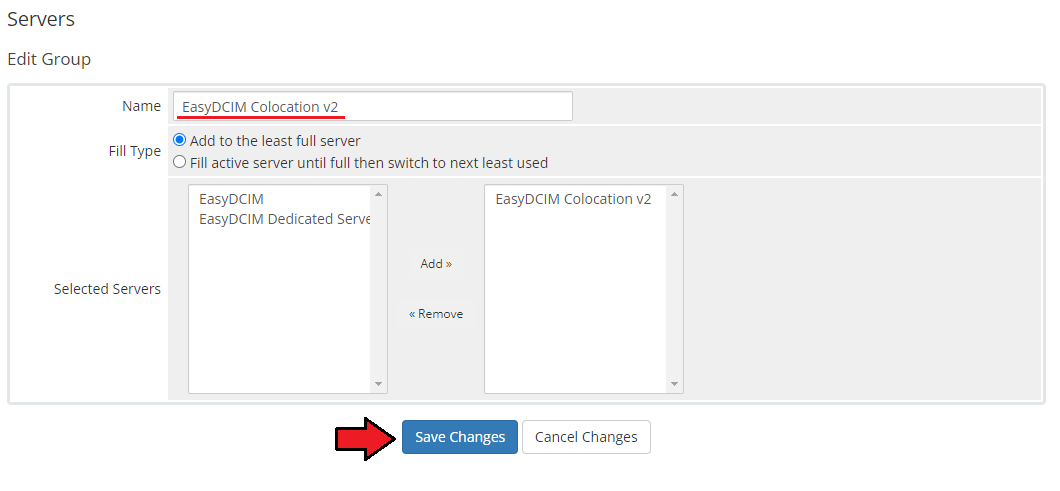
|
Configuration of Product
| 7. In order to create and configure a product, go to 'System Settings' → 'Products/Services'. Click on 'Create a New Group'. |

|
| 8. Enter the product group name and press 'Save Changes'. |
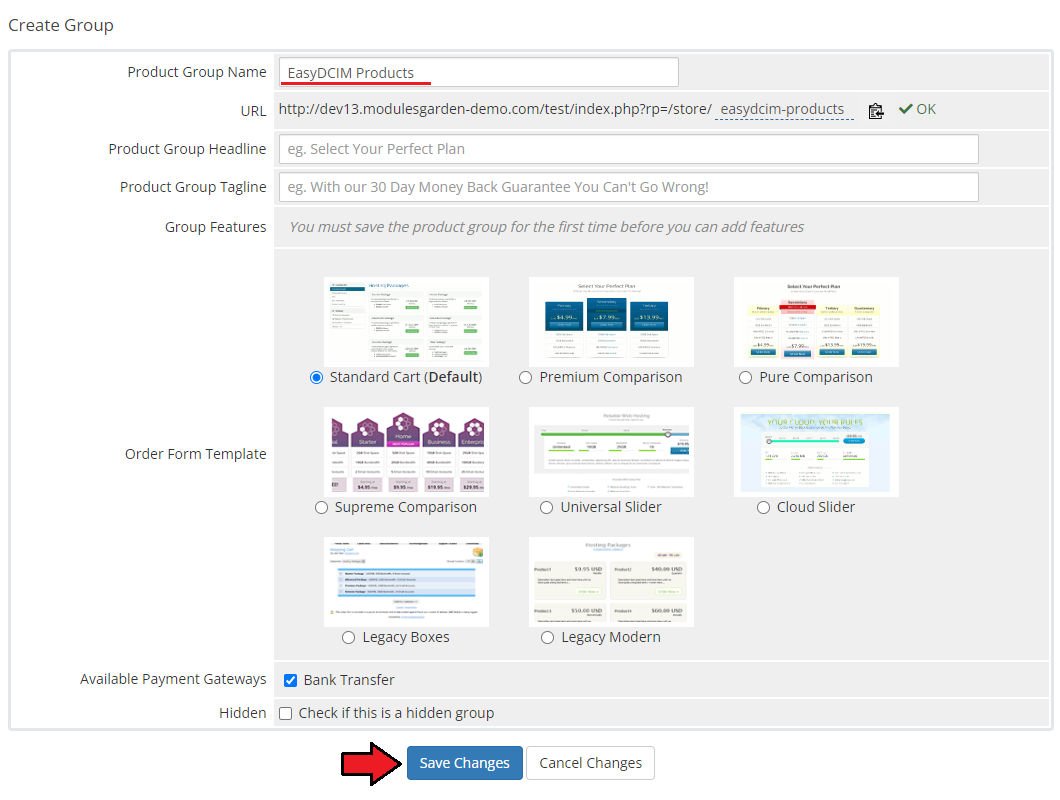
|
| 9. Once you have a product group, you can assign your product to it. To create a product, click on 'Create a New Product'. |

|
| 10. Next, choose your product group, enter your product name and then press 'Continue'. |
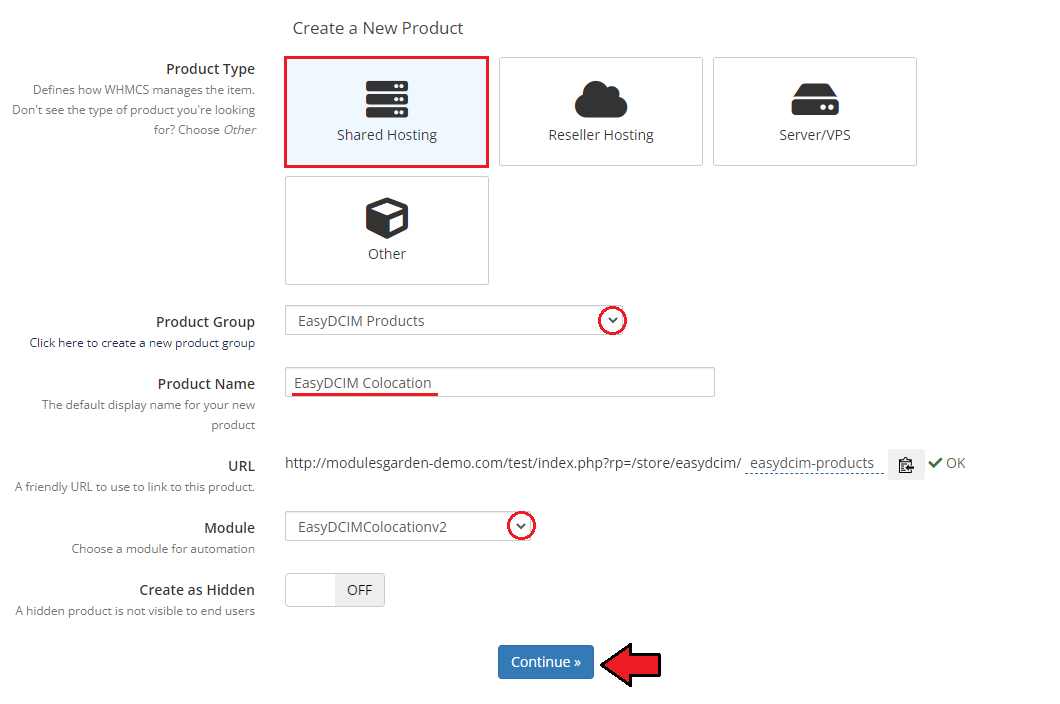
|
| 12. Now, move to the 'Module Settings' section. Keep in mind that the module configuration is only partly obligatory. The server will be assigned based on the provided configuration, and will therefore match only those options that have been specified. Default Options:
Note: generate configurable options if you want to overwrite the 'Location' and 'Model' in the 'Default Options' Automation Settings
Client Area Features- define the features and information that will be available for customers in the client area
Email Notifications
|
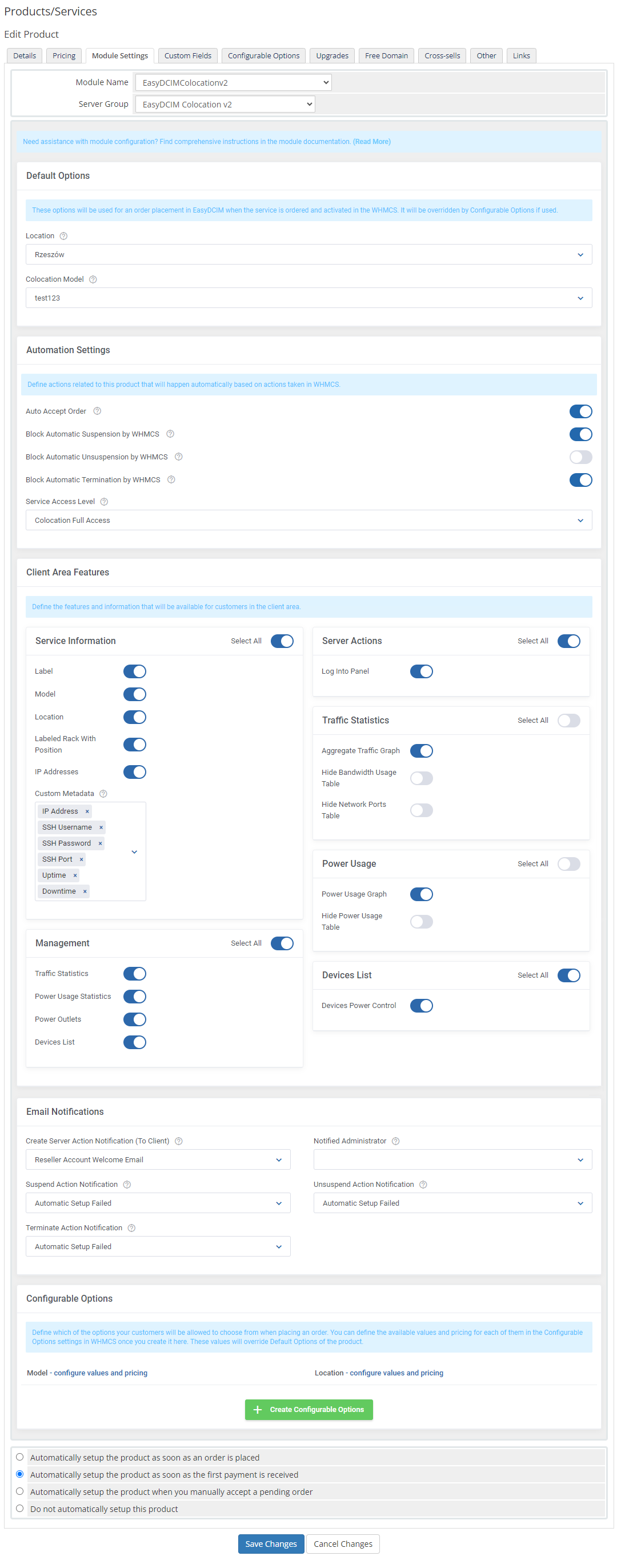
|
| 13. You can also generate the default configurable options to allow your customers place orders tailored exactly to their needs. To do that, go to 'Setup' → 'Products/Services' → 'Configurable Options'. |

|
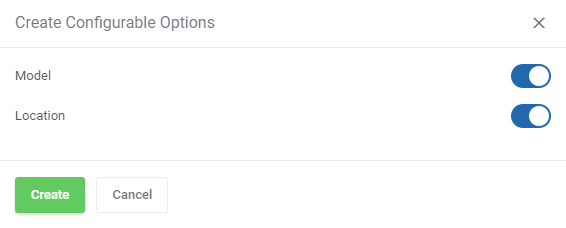
|
Billing Configuration
| 14. Additionally, you can set up a percentile billing for additional traffic. Note: This option is possible only if you do not have Advanced Billing Form WHMCS module installed. If you need a bit more advanced billing integration, please go here for more information.
E.g. If 'Soft Limit = 100' and 'Cost = 0.500' and the client exceeds the bandwidth by 10 Mbps, reaching to '110 Mbps' , they will be additionally charged with $5 USD (10 x 0.500). |
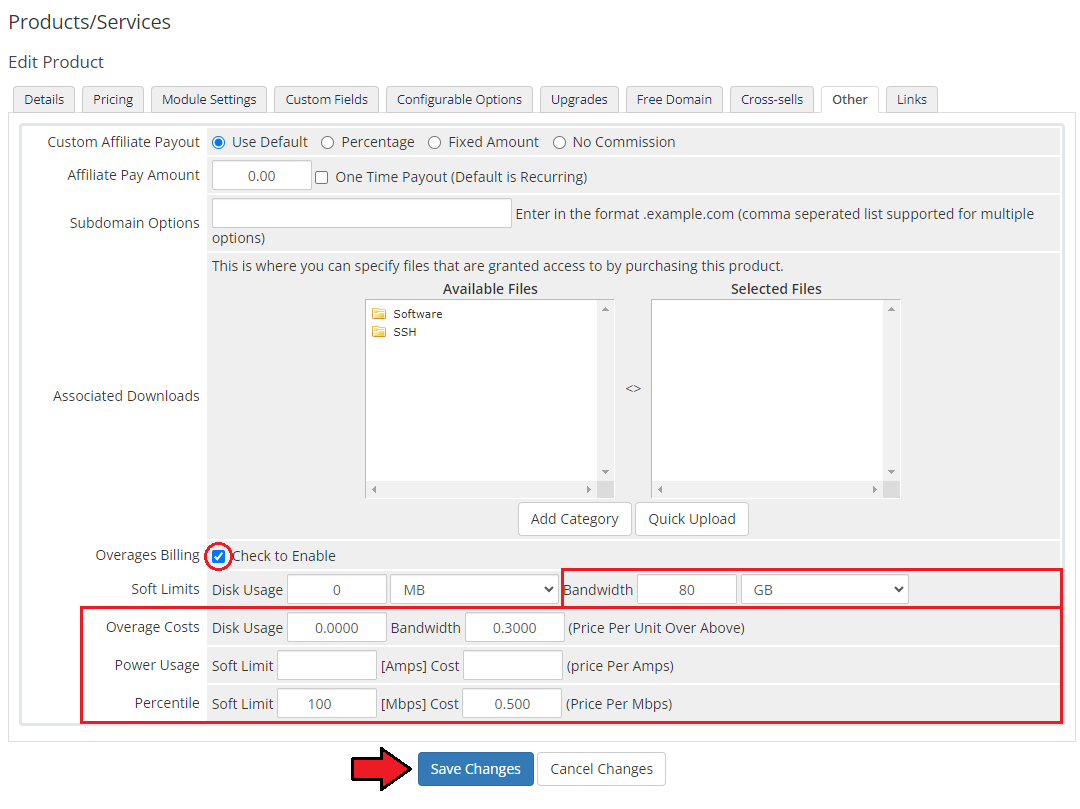
|
Custom Fields
| Once the configuration of the module settings has been completed, the following custom fields will be created automatically. Note: These fields will not be visible to your clients by default.
|
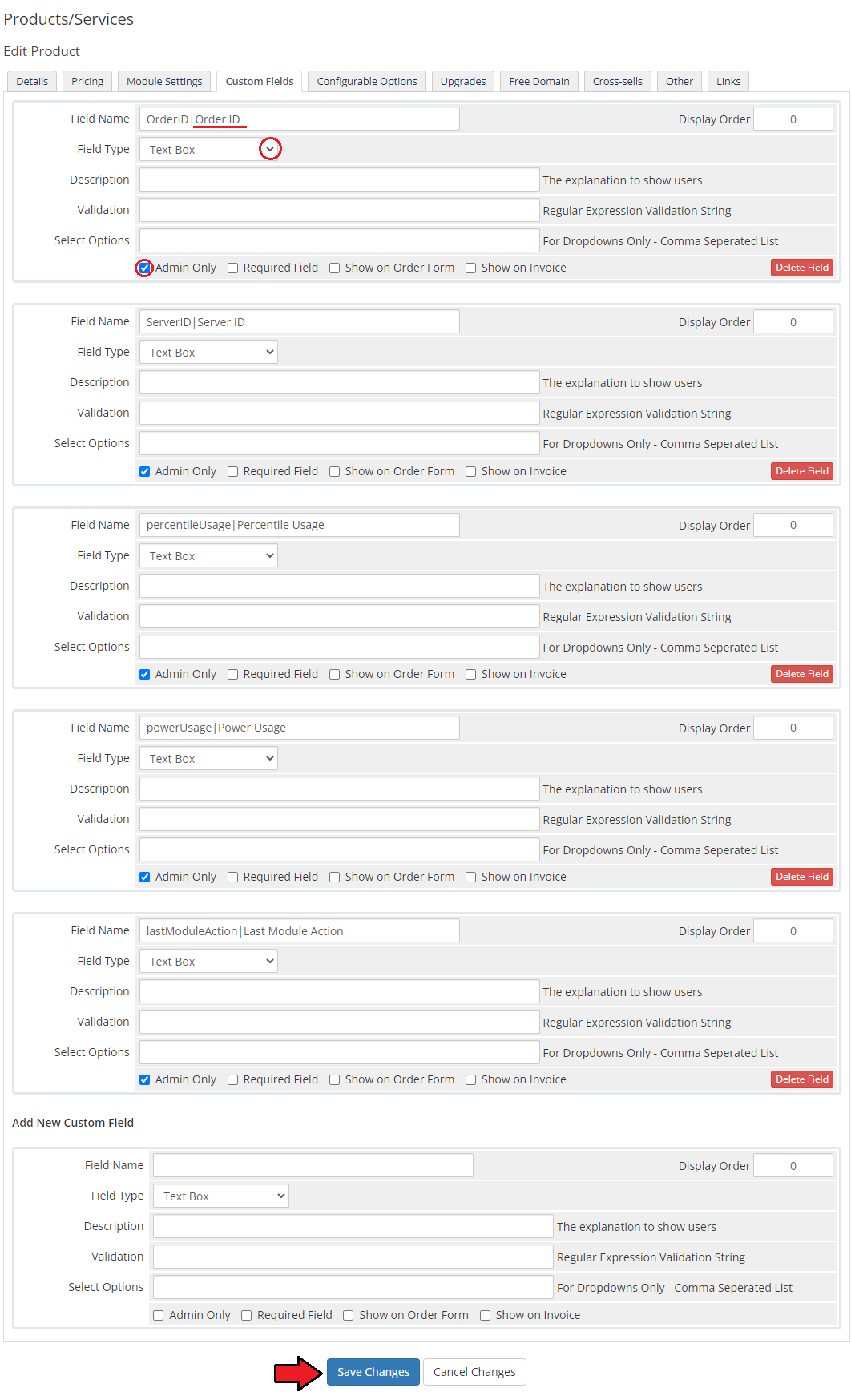
|
Management
| In this section we will show you all functionalities of EasyDCIM Colocation For WHMCS. Our module allows you to offer and manage EasyDCIM colocation service right in your WHMCS system. |
Admin Area
|
As soon as you set up a server for a client, you can perform various actions and view server details from the WHMCS admin area.
|
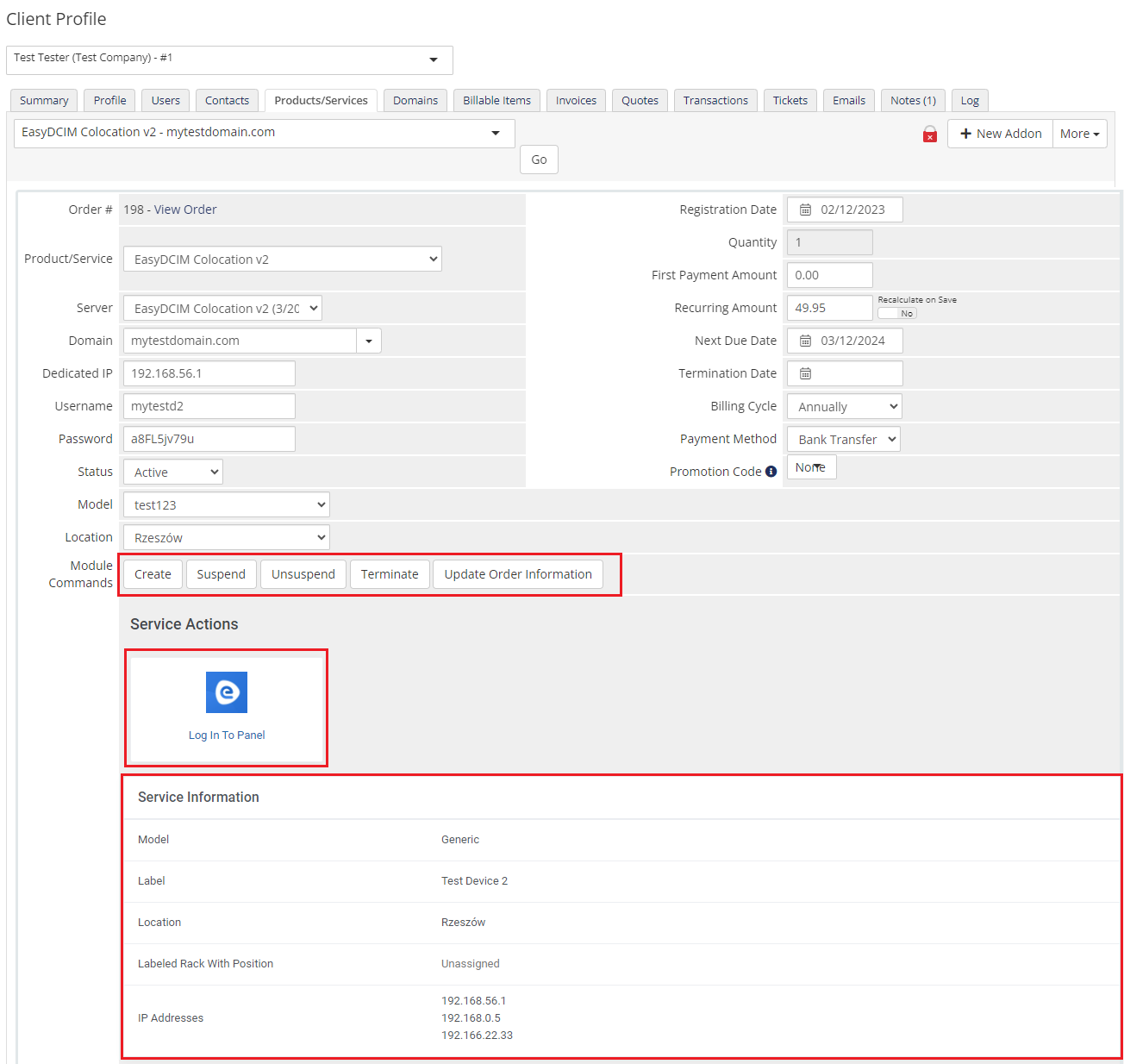
|
| Below these functions you can also view traffic and power usage statistics and even specify the time intervals. |
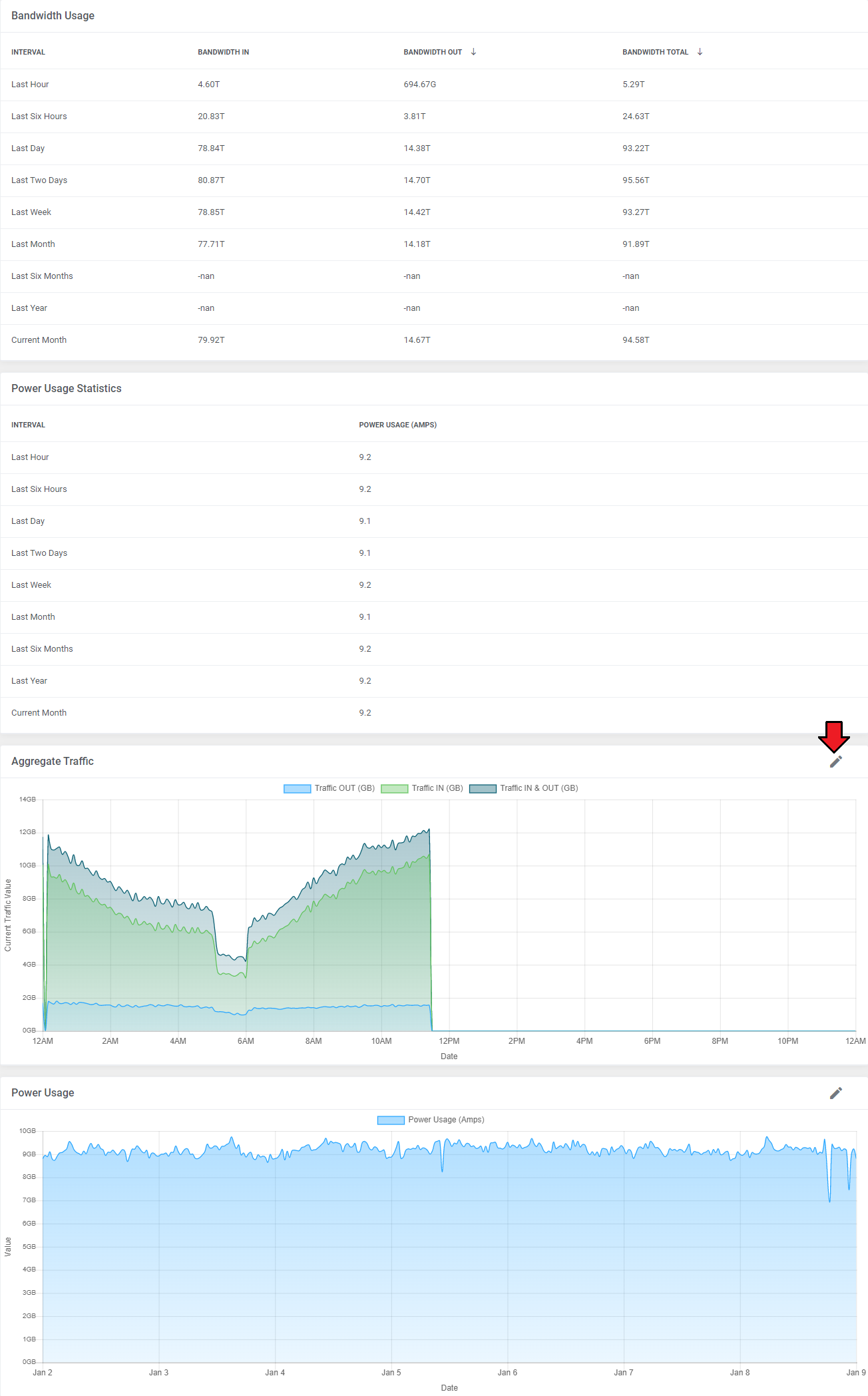
|
| Lastly, you can also see the custom fields with currently assigned 'Order ID' and 'Server ID' from the EasyDCIM panel. An empty 'Server ID' field means that it has not been automatically assigned by the cron yet (e. g. it may not be activated in the EasyDCIM panel yet). |

|
Client Area
| In the main view of the client area your customers can check basic details of a colocation service as well as log in to their EasyDCIM control panel with a single click. |
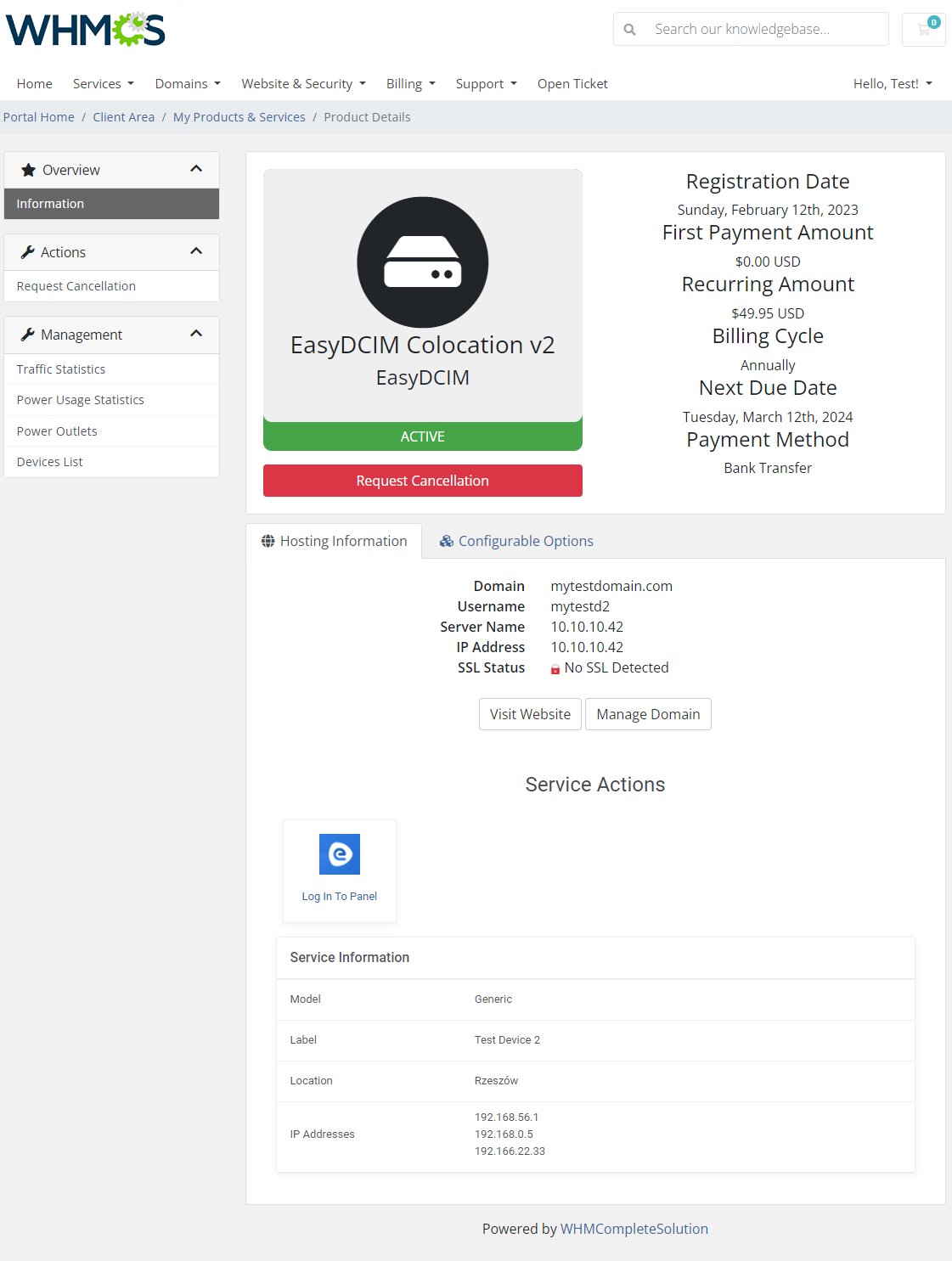
|
Traffic Statistics
| They can view the graphs with traffic statistics and even define time intervals. Note: Available graphs and time intervals depend on the product registration date. |
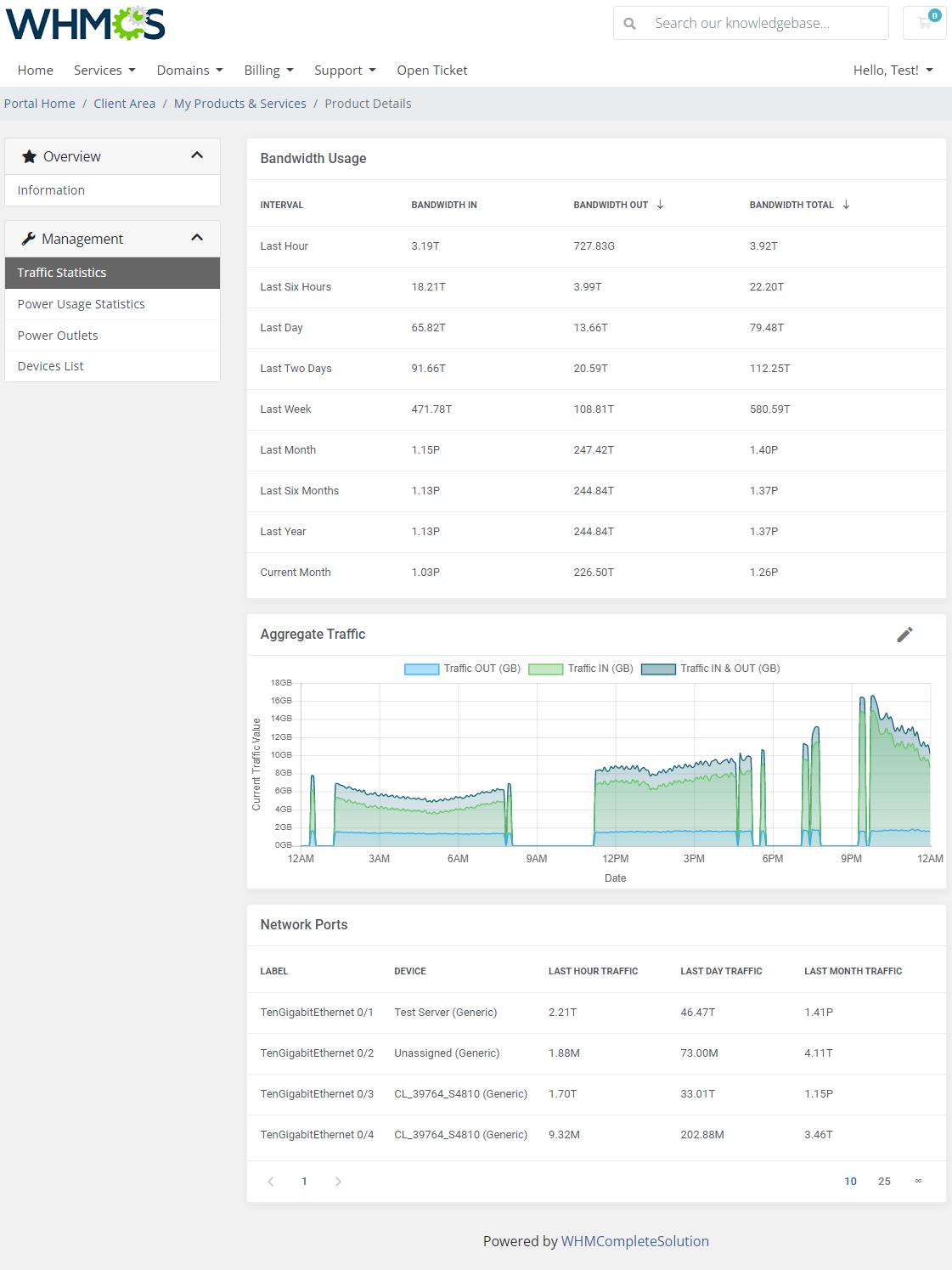
|
Power Usage Statistics
| The same goes for power usage statistics. |
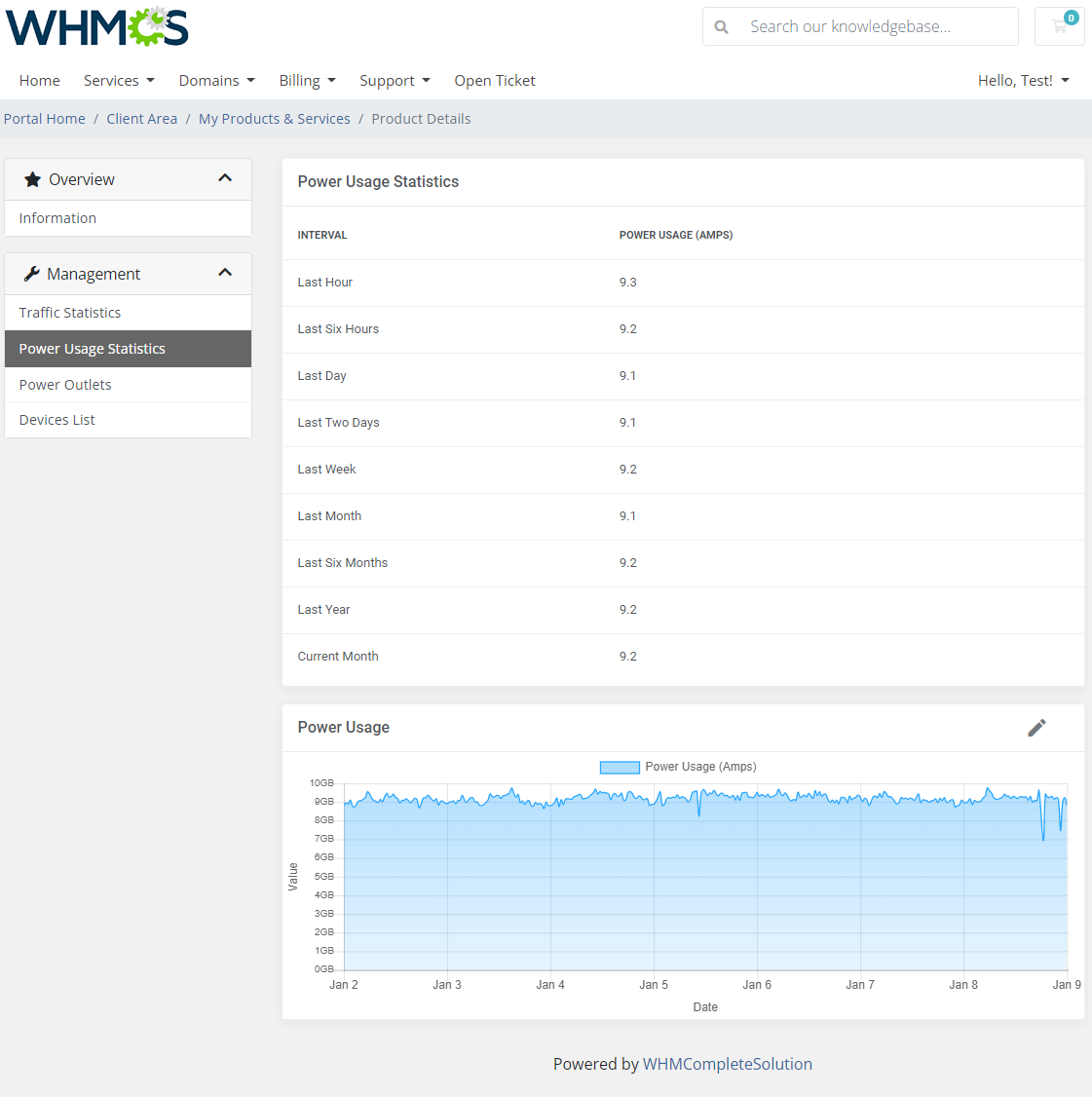
|
Power Outlets
| Additionally, your clients can see the current state of all power outlets with the possibility to turn them on, off or restart. |
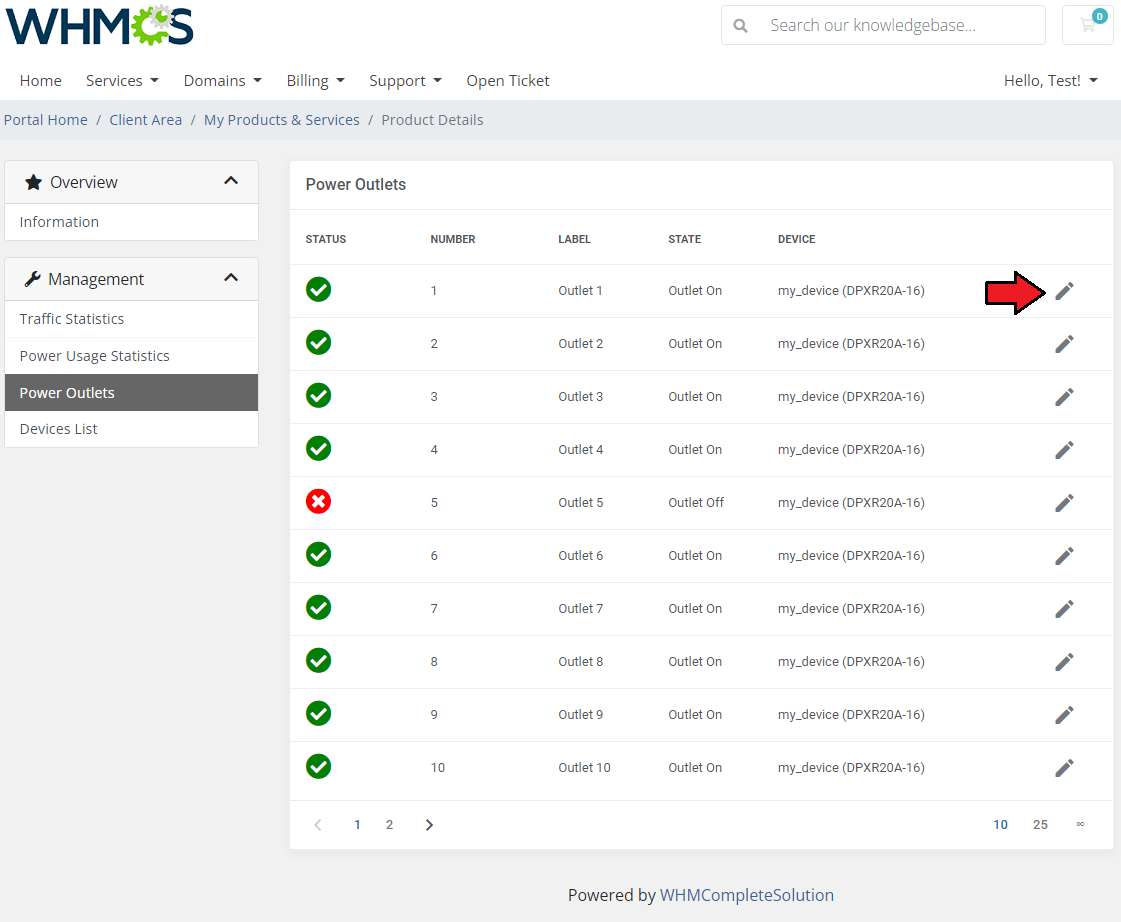
|
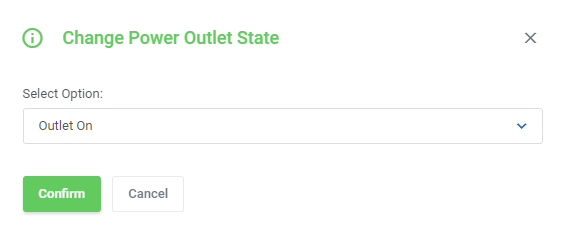
|
Devices List
| Information regarding devices can be found on the 'Devices List,' this includes their name, IP and location. If the 'Devices Power Control' option is enabled, the users will find remote control buttons next to each device, allowing them to restart, shut down, and power on the device. |
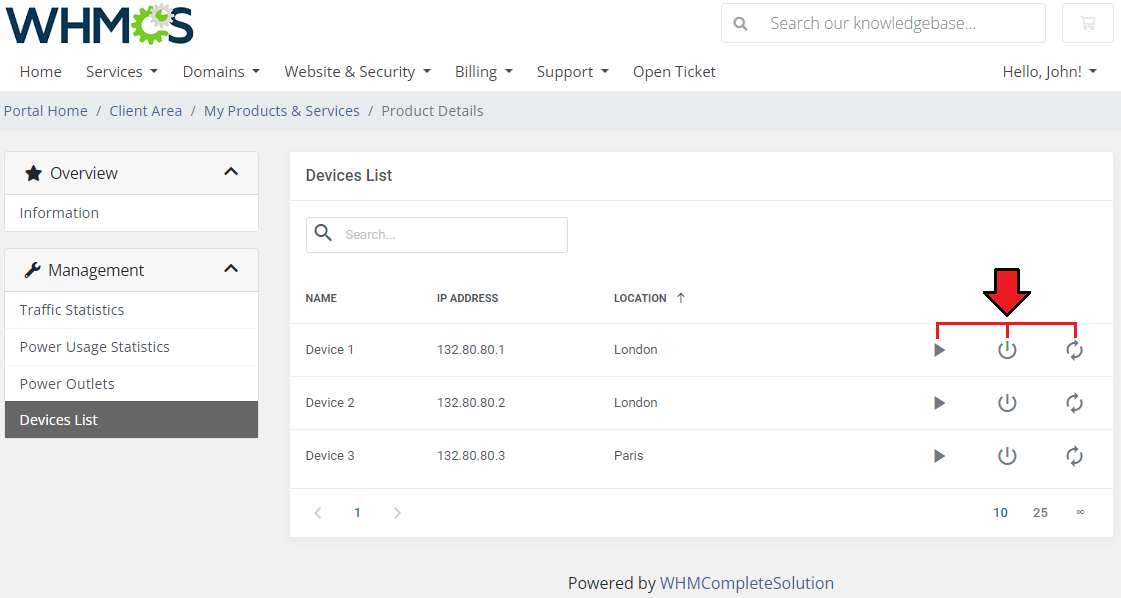
|
Reverse DNS
| Your clients have the ability to manage their reverse DNS records. They can either modify existing records or create new ones. |
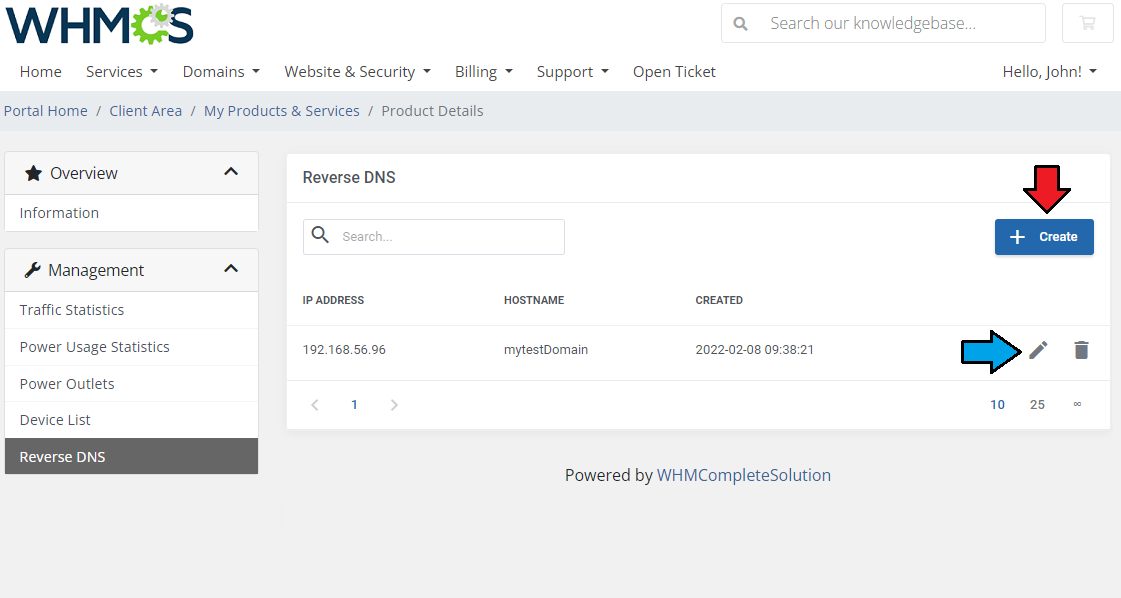
|
| To create a new record, clients simply need to provide the required information. The newly created record will instantly appear in the list.
If you are creating a single record, leave the 'Mask' field blank. |
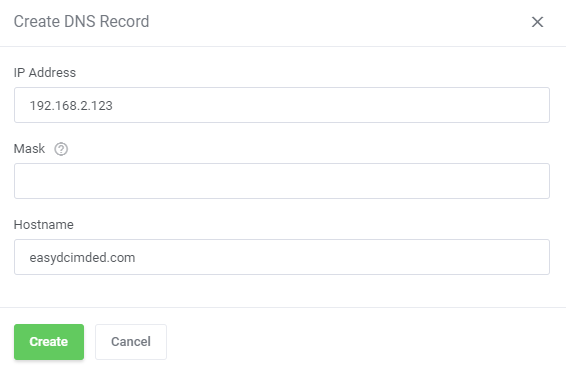
|
Advanced Billing Integration
| EasyDCIM Colocation For WHMCS supports integration with the Advanced Billing For WHMCS module. This allows you to charge your customers for total bandwidth (In, Out and Total), power usage and 95th percentile (In, Out and Total) billing for additional traffic. Note: We suggest to run the cron only once per hour (with the interval of 3600 seconds). |
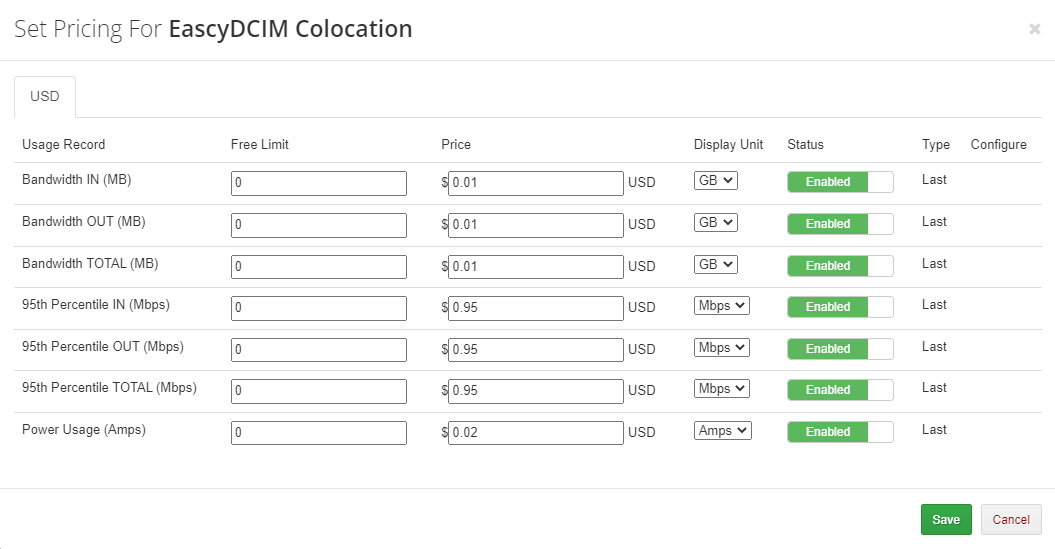
|
| Once the relevant options are enabled, your clients will also be able to view billing for the current usage in your client area. |
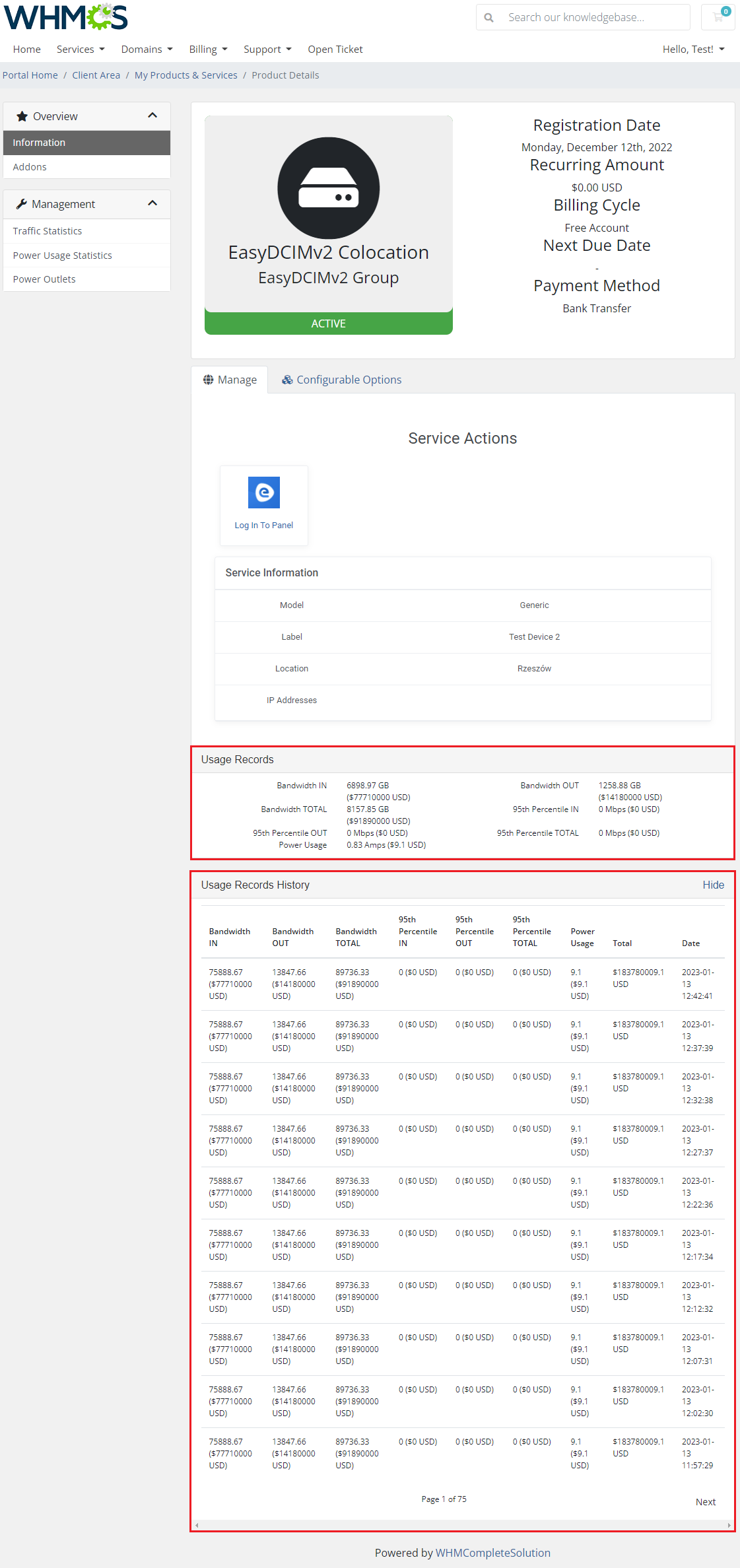
|
Tips
| 1. Note that placing two identical orders may result in assigning servers with slightly different parameters.
It is a natural result of how server matching in EasyDCIM works. In brief, it matches a server basing on the resources and models precised in the order, without considering other resources. |
How To Use Language Overrides
| Incorporating language customizations - the module readily accommodates language overrides, allowing you to tailor the language files to your preferences. The language file english.php remains unencoded and can be modified to suit your needs. However, it's recommended to avoid altering the core file itself, and instead, leverage the capability of using overrides. |
Here's how to apply language overrides:
~/langs/overrides/english.php.
For example: Original yourWHMCS/modules/servers/moduleName/langs/english.php: $_LANG['Search'] = 'Search'; Override yourWHMCS/modules/servers/moduleName/langs/overrides/english.php: $_LANG['Search'] = 'Look for'; |
| By following these steps, you can seamlessly implement language customizations without altering the core language file, ensuring your changes will not be lost after every module update. Remember that some of the modules have more than one language file, located under /addons and /servers paths. You may create the override files for both of them. |
Update Instructions
General Guidelines
| An essential guidance through the process of updating the module from version 2.x to a higher one is offered here. Ensure successful completion of the module update by carefully following each step, thereby preventing data loss or any unforeseen issues. |
Migration From 'V1' To 'V2' Module Version
| If you are updating your EasyDCIM Colocation For WHMCS module from version 1.x to 2.x, follow the steps below to ensure a smooth migration without errors. |
| Important: Back up your WHMCS files and database before starting the update to avoid data loss in case of failure. |
| 1. Create a backup of your WHMCS files and database to prevent data loss. |
| 2. Log in to the client area and download the latest version of the module. |
| 3. Upload and extract the new module files into your WHMCS root directory. |
| 4. Navigate to System Settings → Servers. Create a new server and server group for the EasyDCIMcolocationv2 module. |
| 5. Go to System Settings → Products/Services. Find and open the product you wish to update. |
6. Open the Custom Fields section, and correct the existing custom fields names as shown below:
|
| 7. Open the Module Settings section of the product of your interest, find and open the product you are going to update. |
| 8. Change the 'Module Name' from "EasyDCIMColocation" to "EasyDCIMColocationv2". Change the 'Server Group' to the created in the step 4th one. |
| 9. Configure the module settings from scratch and save the changes. |
| 10. Generate any configurable options if needed. |
11.* Regarding billing methods update:
|
Common Problems
| 1. When you encounter problems with connection, check whether your SELinux or firewall does not block ports. |